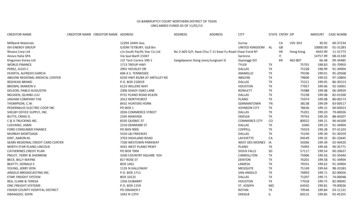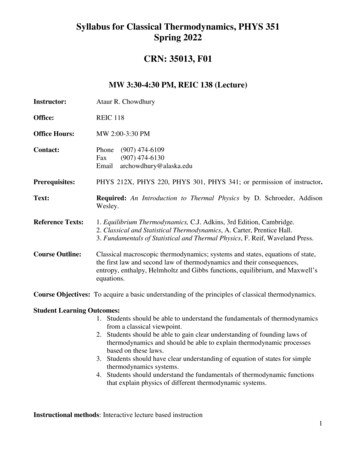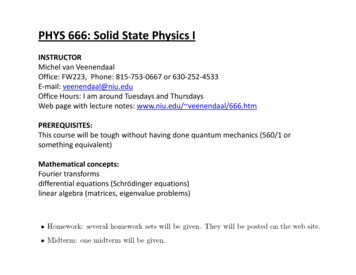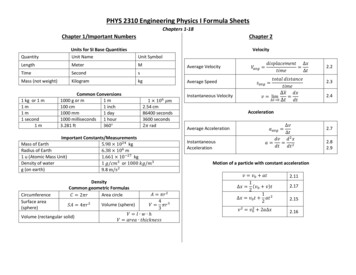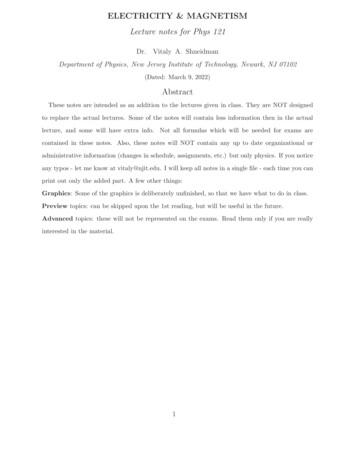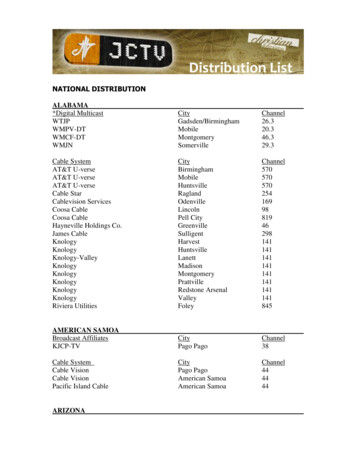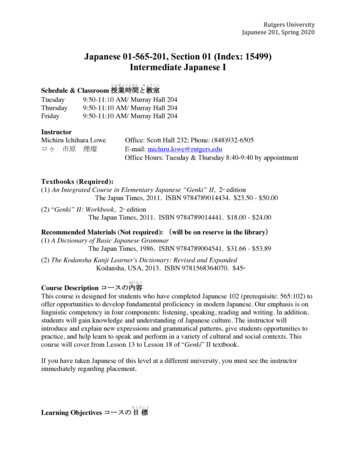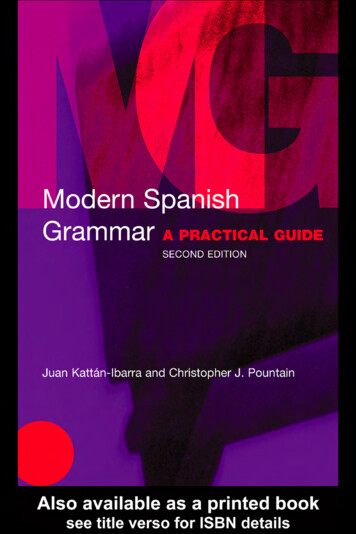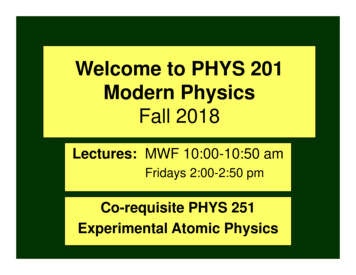
Transcription
Welcome to PHYS 201Modern PhysicsFall 2018Lectures: MWF 10:00-10:50 amFridays 2:00-2:50 pmCo-requisite PHYS 251Experimental Atomic Physics
TextbookRequired text:Modern Physics by R. A. Serway, C. J.Moses, C. A. Moyer,Possibly useful math resource:M. L. Boas, Mathematical Methods inthe Physical Sciences, 3rd Ed.
GradingDefault grade assignmentA94 B-80A-90 C 77B 87 C74B84 C-70There will be extra creditopportunities!This assignment may beadjusted for the test scores.
Homeworkhttp://www.physics.wm.edu/ inovikova/phys201/CourseSchedule.htmProblem sets: 11 assignments (turned in on paper), due beginning ofthe corresponding Friday class. Late assignments will be accepted witha 50% penalty when submitted on or before Monday class following thedue date. Any assignment turned in after that time will not be accepted(unless you obtained a permission form me beforehand).
Homeworkhttp://www.physics.wm.edu/ inovikova/phys201/CourseSchedule.htmReading assignments: (roughly) weekly reading assignmentsregarding the historical significance of the events discussed in class.After each discussion, you should write about ½ page of thoughts,comments, and questions about the material (submitted in Blackboard).
My contact informationOffice: Small 251E-mail: ixnovi@wm.edu or inovikova@physics.wm.eduOffice hours: W 11am – 1pm or by appointmentTelephone: (757) 221-3693Web-site:http://www.physics.wm.edu/ inovikova/phys201.html orin BlackboardArea of research: experimental atomic physics and quantum opticsResearch projects: quantum memory and slow light, miniatureatomic clocks, “squeezed” light, optical microresonators, opticalproperties of thin films, etc.Lab location: Small 65, 34 (basement)Web-site: http://physics.wm.edu/ inovikova/group.html
Necessary backgroundPrerequisites: This course assumes a solid backgroundin first year physics and math.- Full year of calculus-based general physics PHYS101-102.- Algebra-based general physics courses PHYS 107108 are often not sufficient.- AP Physics is usually not sufficient.- Full year of calculus at the level of Math 111-112 (andhere AP credit is sufficient).This is a fast-paced and challenging course.Judge your preparedness before you dive in!
Modern physics: Road MapWhere things getscuriouser andcuriouser
Birth year of modern physics - 1895TelephonesAutomobilesElectricityIndustry (steam engine-driven)
“Classical” physics – XIX century Mechanics Electromagnetism Thermodynamics OpticsPhysics at the end of the XIX centuryapproached its ultimate goal: to produce aclear deterministic description of the world(as observed by humans).
Axioms of the “classical” physicsAll theproperties of anyobjects can bedetermined witharbitraryprecisionTime is auniversal propertyAny property ofan object at anymoment of timecan becalculated fromthe object’sproperties at onemoment of timeThe act of themeasurementdoes not change All matter can be described as a collectionthe state of the of particles. Collective motion of suchparticles can be described as a wave, aobjectdelocalized oscillation of a matter.
“Classical” physics: MechanicsIf one knows the position of an object, and all forcesacting on it, one can use Newton’s laws of motion topredict with certainty, where the object will be in thefuture (or where it was in the past).
“Classical” physics: ElectromagnetismGauss’s law (electricity)Gauss’s law (magnetism)Faraday’s lawAmpere’s lawr r E 0r r B 0rr r B E trr r 1 E B 2c tIf one knows the positions and velocities of anyelectrical charges of an object, one can useMaxwell’s equations to describe electrical andmagnetic forces acting on them.
“Classical” physics: ElectromagnetismGauss’s law (electricity)Gauss’s law (magnetism)Faraday’s lawAmpere’s lawIf one knows the positions and velocities of anyelectrical charges of an object, one can useMaxwell’s equations to describe electrical andmagnetic forces acting on them.And even explain the nature of light and derive all laws of optics!(well, almost )
“Classical” physics:Thermodynamics
“Classical” physics:ThermodynamicsStatistical treatment is introduced for the first time!The behavior of a complex system can be predictedaccurately without detailed knowledge of individualbehavior of each component.
Status of physicsThere is nothing new to be discovered in physics now. All that remainsis more and more precise measurements.The more important fundamental laws and facts of physical sciencehave all been discovered that the possibility of their ever beingsupplanted in consequence of new discoveries is exceedinglyremote Our future discoveries must be looked for in the sixthsplace of decimals.
Status of physicsThere is nothing new to be discovered in physics now. All that remainsis more and more precise measurements.Lord Kelvin, 1900The more important fundamental laws and facts of physical sciencehave all been discovered that the possibility of their ever beingsupplanted in consequence of new discoveries is exceedinglyremote Our future discoveries must be looked for in the sixthsplace of decimals.A. A. Michelson, 1900
Birth of “modern” physicsIn a speech to the Royal Institution in 1900, LordKelvin himself described two “dark clouds on thehorizon” of physics:The question of the existence of an electro-magneticmedium—referred to as “ether” or “aether.”Special relativityThe failure of classical physics to explain blackbodyradiation.Quantum mechanics
Birth of modern physics (cont) Discovery of the X-rays (Roentgen, 1895) Discovery of Radioactivity (Becquerel, 1896)Nuclear physics Discovery of the electron (Thomson, 1896) Discovery of the Zeeman effect - splitting of atomicspectral lines in magnetic field (Zeeman, 1897)Quantum mechanics, atomic physics
Axioms of the “Classical” physicsAll theproperties ofany objectscan bedeterminedwith arbitraryprecisionThe act of themeasurementdoes notchange thestate of theobjectTime is auniversal propertyAny property ofan object at anymoment of timecan becalculated fromthe object’sproperties at onemoment of timeAll matter can be described as a collectionof particles. Collective motion of suchparticles can be described as a wave, adelocalized oscillation of a matter.
Axioms of the “Classical” physicsAll theproperties ofany objectscan bedeterminedwith arbitraryprecisionThe act of themeasurementdoes notchange thestate of theobjectTime is auniversal propertyAny property ofan object at anymoment of timecan becalculated fromthe object’sproperties at onemoment of timeAll matter can be described as a collectionof particles. Collective motion of suchparticles can be described as a wave, adelocalized oscillation of a matter.
Axioms of the “Classical” physicsAll theproperties ofany objectscan bedeterminedwith arbitraryprecisionThe act of themeasurementdoes notchange thestate of theobjectTime is auniversal propertyAny property ofan object at anymoment of timecan becalculated fromthe object’sproperties at onemoment of timeAll matter can be described as a collectionof particles. Collective motion of suchparticles can be described as a wave, adelocalized oscillation of a matter.
Axioms of the “Classical” physicsAll theproperties ofany objectscan bedeterminedwith arbitraryprecisionThe act of themeasurementdoes notchange thestate of theobjectTime is auniversal propertyAny property ofan object at anymoment of timecan becalculated fromthe object’sproperties at onemoment of timeAll matter can be described as a collectionof particles. Collective motion of suchparticles can be described as a wave, adelocalized oscillation of a matter.
Why this course is challenging? The effects we are going to discuss areoutside of our everyday experiences. We have no intuition to guide us. The correct solution may seem as weirdas any incorrect one.
Which square is darker: A or B?
Which square is darker: A or B?
Which end of the strip is darker?
Which end of the strip is darker?
So, you see why this course ischallenging?People Aren’t Dumb. The World Is Hard.R. H. Thaler, father of behavioral economics
So, you see why this course ischallenging?People Aren’t Dumb. The World Is Hard.R. H. Thaler, father of behavioral economicsStudents Aren’t Dumb. The Physics Is Hard.I. Novikova, Modern Physics instructor
in first year physics and math. - Full year of calculus-based general physics PHYS 101-102. - Algebra-based general physics courses PHYS 107-108 are often not sufficient. - AP Physics is usually not sufficient. - Full year of calculus at the level of Math 111-112 (and here AP credit is sufficient). This is a fast-paced and challenging course.
